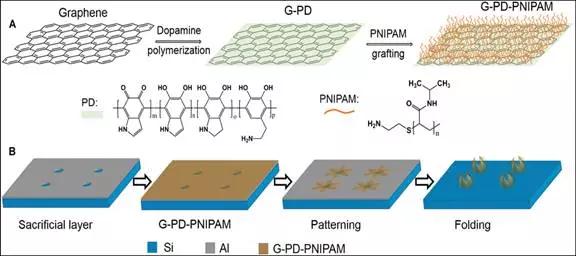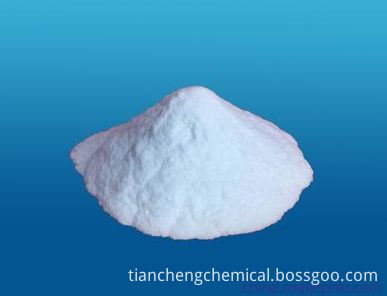U.S. developed ultra-thin heat-sensitive self-folding 3D graphene preparation method
Because 2D materials such as graphene have a wide range of unique physical and chemical properties, they have been widely used in flexible electronics, energy conversion and storage, plasma and sensors, and have been widely studied, but most of the research work is based on these. The 2D material is in an intrinsic planar geometry. However, the curved and folded structure with miniaturization characteristics can bring great application prospects to, for example, wearable electronic devices, biological or dispersible sensors, actuators and the like. In addition, it has been suggested that the physical and chemical properties of these 2D materials may be strongly affected by curvature, wrinkles and creases. The usual technical means to transform these atomic planar materials into 3D geometries by bending, wrinkling or folding can significantly change their properties and produce novel structures and compact devices. Currently, research on graphene folding or wrinkling is mainly The atomic thickness of graphene and the extremely low bending stiffness are utilized. For example, suspended graphene sheets can be folded under strong mechanical external forces, or by using curved templates during growth and transfer. In addition, it has been studied to use a polymer-graphene bilayer structure which is interfacial tension and pre-tensioned or thick gradient cross-linked to achieve wrinkling and folding of graphene. However, the accuracy and tunability of the three-dimensional geometry formed by these methods are limited, and because of their dependence on thick substrates or multilayer structures, this requires harsh conditions and can significantly thicken the folded graphene. Theoretical studies have shown that this folding can be precisely controlled to produce a novel three-dimensional geometry. However, self-folding controlled by external environmental stimuli (such as temperatures compatible with biological systems) has not yet been validated. This controlled self-folding is very difficult to achieve with raw graphene because the chemical properties of graphene itself are very stable. Therefore, surface functionalization of graphene is necessary while retaining sp2 hybridization of graphene and excellent intrinsic electrical properties are also important. Recently, Johns Hopkins University of the United States has developed a preparation method for preparing ultra-thin heat-sensitive self-folding 3D graphene. The single layer graphene is folded and unrolled into a pre-designed ordered 3D structure. This method uses polydopamine to functionalize the graphene surface in a non-covalent manner. The functionalized graphene is photolithographically patterned and self-folded into an ordered three-dimensional structure that is completely temperature controlled and reversible. The structure is characterized by spectroscopy and microscopy, rationalizing self-folding using multi-scale molecular dynamics models. This study offers the potential to design and fabricate ordered 3D graphene structures with predictable shape and dynamics. Researchers say the technology can be used to seal viable cells, create nonlinear resistance, and add wrinkles to transistor devices. The researchers modified the surface of graphene to impart heat sensitivity and patterned the functionalized graphene into ultra-thin self-folding precursors. Surface functionalization and patterning of single-layer graphene First, graphene is surface functionalized in a non-covalent manner using a bioadhesive, polydopamine (PD). Due to its reactivity to catechol/indole groups, PD is also capable of performing a variety of chemical reactions for subsequent functionalization, so the responsiveness of poly(N-isopropylacrylamide) (PNIPAM) used in this study The polymer can be further grafted to the surface. The functionalized single layer graphene is then patterned into various sizes and shapes using photolithography and plasma etching. Finally, the functionalized graphene pattern is released from the substrate, and upon heating the lower critical solution temperature (LCST) of PNIPAM, the 2D precursor folds itself into an ordered 3D microstructure, which is the molecule of the grafted polymer brush. Caused by changes in conformation. The functionalized graphene is very thin, ranging from 5 nm to 10 nm. In addition, the non-covalent bond method preserves the intrinsic properties of graphene and low bending stiffness. By using a computer-aided design of the photomask, the shape of the 2D precursor can be effectively controlled to achieve a shape-adjustable effect. This new method has two major advantages. First, it can avoid the damage of graphene characteristics in the previous process, and the folding process can completely retain the electrical and thermal conductivity of graphene. Second, the crease in the 3D shape can form energy. The band gap further improves the electrical conductivity of the graphene. The ultra-thin, heat-sensitive self-folding 3D graphene can be used to make foldable electronic devices, as well as a range of 3D carbon structures associated with biosensing and molecular robotics.
Silicon dioxide nano particles are known as Nano Silica, it is also called Silica Nano-Particles. It is used particularly in the Biomedical researches. This nano silica is expected to be very much stable and to have very low level of toxicity. It is also used as concrete or cement admixture with aim to improve concrete pressure strength.
Nano Silica Nano Silica,Silica Nano-Particles,Concrete Nano Silica,Nano Silica SP30 Shandong Tiancheng Chemical Co., Ltd. , https://www.akdchemical.nl
